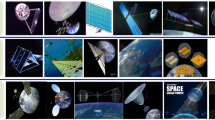Abstract
The analysis of solar energy conversion methods in the projects of solar power satellites (SPS) has been conducted and the problems restraining their implementation analysed. Therefore, the article provides grounds for using promising heat-resistant materials of carbonic nanocomposite and low-temperature superconductors in the scheme of solar energy conversion with the purpose of creating SPS projects of a new type with improved weight and size parameters and physical and technical characteristics. The difference between the gyroscopic solar power satellites (GSPSs) with the new thermal conversion system (TCS) and superconductive generator projects and the previous ones lies in the absence of steam and gas turbine plants, a thermal radiator and a system of direction to the sun. The results of assessment of their energy and weight and size parameters have been presented: the thermal efficiency of conversion by the helium as working fluid at concentration of the solar energy of 74 and by the water steam at 38 has made 85% and 62.7% respectively; the specific weight of the entire thermal conversion system has made 2.17 kg/kW and 2.61 kg/kW; its specific capacity – 12.3 and 6.79 kW/m2, the specific weight of the GSPS with the new TCS and superconductive generator has made 0.46 and 0.38 kW/kg. The suggested principle of functioning may be used in space power plants, being based on planets and the Moon.





Similar content being viewed by others
REFERENCES
Glaser, P.E., AIAA Papers, 1977, vol. 77–352, p. 12.
Woodcock G. and Gregory, D., in Proceedings of the 10th JECEK, New York, 1975, p. 1057.
Gregory, D.L., Energy, J., 1977, vol. 1, no. 2, p. 85.
Gregory, D.L., in Proceedings of the 12th JECEK, New York,1977, p. 1386.
Manoff, M., in Proceedings of the 13th JECEK, New York,1978, p. 185.
Ludanov, K.I., New method for the transformation of solar radiation energy into electric power for energy feeding of the space vehicles, Kosm. Nauka Tekhnol., 2007, vol. 13, no. 6, pp. 31–38.
Ludanov, K.I., Modification of Glaser project. New thermal cycle for orbital solar electric power station, Kosm. Nauka Tekhnol., 2009, vol. 15, pp. 62–67.
Mar'yinskykh, Yu.M., New generation thermodynamic autonomously managed space solar power plant, J. Eng. Thermophys., 2014, vol. 23, no. 4, pp. 1–6.
Avezova, N.R., Khaitmukhamedov, A.E., Usmanov, A.Yu., and Boliyev, B.B., Solar thermal power plants in the world: the experience of development and operation, Appl. Sol. Energy, 2017, vol. 53, no. 1, pp. 72–77.
Mankins, J.C., A technical overview of the suntower solar power satellite concept, Acta Astronaut., 2002, vol. 50, no. 6, pp. 369–377.
Strebkov, D.S., Solar power engineering in the future world: a view from Russia, Appl. Sol. Energy, 2012, vol. 48, no. 2, pp. 71–75.
Zakhidov, R.A. and Lutpullayev, S.L., Global trends in alternative energies and problems in Uzbekistan for the development of renewable energy sources, Appl. Sol. Energy, 2015, vol. 51, no. 1, pp. 50–61.
Grilikhes, V.A., Orlov, P.P., and Popov, L.B., Solnechnaya energiya i kosmicheskie polety (Solar Energy and Space Flights), Moscow: Nauka, 1984.
Kudrin, O.I., Solnechnye vysokotemperaturnye kosmicheskie energodvigatel’nye ustanovki (Solar High Temperature Space Power Energy Plants), Moscow: Mashinostroenie, 1987.
Zakharov, A.N., Kovsharov, N.F., Oskomov, K.V., et al., Properties of low-emission coverages on the basis of Ag and Cu inflicted on polymeric tape by the method of magnetron sputtering, Perspekt. Mater., 2012, vol. 8, pp. 65–67.
Two-dimensional-reinforced composite KUP-VM-2, 2012. http://www.advtech.ru/niigrafit/prod/kupvm.htm
Heat Resistant High Strength Composite Carbosil, 2012. http://www.advtech.ru/niigrafit/prod/karbosil.htm
A. Krüger, Carbon Materials and Nanotechnology, Hoboken, NJ: Wiley, 2010.
Delhaes, P., Carbon Science and Technology: From Energy to Materials, Hoboken, NJ: Wiley, 2013.
Barnes, N.P., Michael, D., and Gregory, L.R., Review of high power density superconducting generators: present state and prospects for incorporating YBCO windings, Cryogenics, 2005, vol. 45, pp. 678–680.
Gulamova, D.D., Chigvinadze, D.G., Akrivos, Zh., and Uskenbaev, D.E., Obtaining and studying the properties of high-temperature superconductors of homologous series of Bi1.7Pb0.3Sr-Can – 1CunOy (n = 4–9) under influence of solar energy, Appl. Sol. Energy, 2012, vol. 48, no. 2, pp. 135–139. https://link.springer.com/journal/11949/48/2/page/1
Hull, J.R., Applications of high-temperature superconductors in power technology, Rep. Prog. Phys., 2003, vol. 66, no. 11.
Knysh, L.I., Influence of geometry of concentrator on power-stations, Kosm. Nauka Tekhnol., 2011, vol. 17, no. 5, pp. 20–23.
Abdurakhmanov, A.A., Kuchkarov, A.A., Mamatkosimov, M.A., and Akhadov, Z.Z., The optimization of the optical-geometric characteristics of mirror concentrating systems, Appl. Sol. Energy, 2014, vol. 50, no. 4, pp. 244–251.
Vukalovitch, M.P., Thermophysical properties of water and steam, Mech. Eng., 1967, p. 160.
Raikunov, G.G., Mel’nikov, V.M., Chebotarev, A.S., Gusevskii, V.I., and Kharlov, B.N., Orbital solar power stations as a promising way for solving energy and environmental problems, Therm. Eng., 2019, vol. 55, no. 4, pp. 917–923.
ACKNOWLEDGMENTS
I express my deep gratitude to the colleagues of the Shostka Institute and Sumy State University for the consultation during the creation of the project.
Funding
I express gratitude to the leadership of the institute for partial financial support of the study. This work was carried out as part of the scientific project no. 0113U004881 of the Ministry of Education and Science of Ukraine.
Author information
Authors and Affiliations
Corresponding author
About this article
Cite this article
Mar’yinskykh, Y.M. Gyroscopic Solar Power Satellite with the New Thermal Conversion System and Superconductive Generator. Appl. Sol. Energy 55, 409–420 (2019). https://doi.org/10.3103/S0003701X19060070
Received:
Revised:
Accepted:
Published:
Issue Date:
DOI: https://doi.org/10.3103/S0003701X19060070



